Judan - 2007
Cho Chikun defended the 45th Judan title - he defeated Yamashita Keigo 3-2
Quick links to the games: Game 1 Game 2 Game 3 Game 4 Game 5
(Don't miss this awesome article on game 2 by Pieter Mioch.)
Judan is one of the top seven professional Go titles in Japan. It means "10 dan" in Japanese. Judan is an annual tournament, the previous year's title holder is playing a best-of-five match with the winner of a qualification tournament. The first prize is the equivalent of 120000 US dollars.
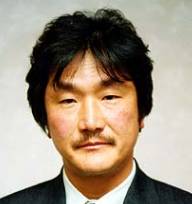
The Judan title holder from last year is Cho Chikun, one of the super-top professional players of the 20th century. He is 50 years old, and studied Go in the Kitani school. He is a Korean national, moved to Japan when he was 6, and became professional shodan when he was 11! He holds a record number of 69 titles - and at some point he was the title holder for all three of Kisei, Honinbo and Meijin top titles, which is still a unique accomplishment.
Cho sensei was also a self-appointed insei teacher at the Nihon Ki-in for quite a while. In 1992 I was the Romanian representative for the WAGC (World Amateur Go Championship) and I visited Igo Kenshu Center (the insei center in Chiba, near Tokyo, where 2 years later I was to live in as an insei). I witnessed Cho Chikun teaching Go to the insei - basically playing fast games with them, and then reviewing the games in great detail.
Here's the story I heard about how Cho sensei became self-appointed insei teacher: as he felt he wanted to give back something to the Japanese Go after a fulfilling career in Japan, he approached the Nihon Ki-in and offered to do voluntary work by teaching the official Nihon Ki-in insei for one year or so, once a week. This is a unique proposition, as far as I know - and the officials at Nihon Ki-in were taken so much by surprise, that they felt obligated to pay Cho sensei a very large fee for his voluntary work...
The biggest Cho Chikun fan outside of Japan seems to be Jan van Rongen, and his Friday Night Files webpage is nothing less than a shrine for Cho Chikun: you can find there most of Cho sensei's games, including his insei games!
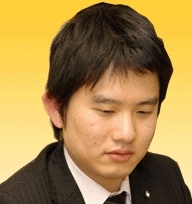
The challenger is Yamashita Keigo, 28, a student of Kikuchi Yasuro, who just defended his Kisei title.
Game 1
Game 1 was played on March 8th, 2007. Cho Chikun won by resignation.
Cho won the first game in an impressive manner: it was a fighting game from beginning to end. Here is the final position of the game: Black resigned after White 172 in Dia. 1, which makes miai A (which saves some key White stones and force the huge black group in the center to live small with 2 eyes) and something around B, which makes a huge territory for White.
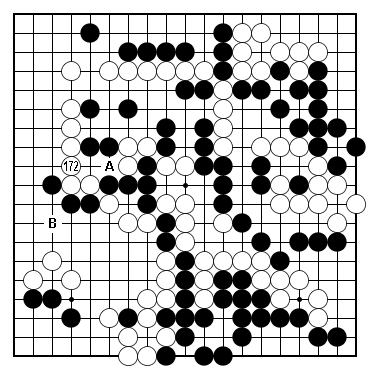 Dia. 1
Dia. 1One of the key points in the game occured in the following position in Dia. 2, where Black played atari with the triangle marked move on the lower side. What should White play next?
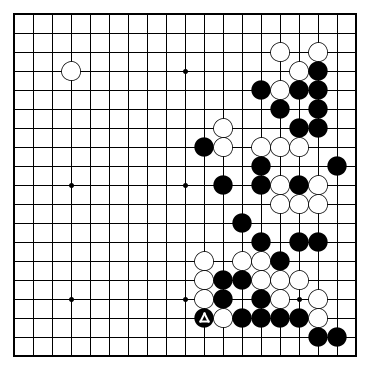 Dia. 2
Dia. 2White cannot save his stone in atari, so one obvious way to continue for White is to sacrifice it as in Dia. 3. There are several problems with this approach, though:
- White worries about Black A next.
- White's wall on the left is not perfect: Black can play a tesuji at B.
- White's wall on the left is too far away from the lower-left corner to have much influence there, in case Black plays first in that corner.
 Dia. 3
Dia. 3The key here is the proverb "Sacrifice two stones instead of one". The reason behind the proverb: when we sacrifice one stone (which is already in atari) we only get one forcing move. When we sacrifice two stones, we'll get at least two forcing moves on the outside, which normally more than make up for a few lost points.
Dia. 4 shows what happened in the actual game. White is not worried about Black B in the previous diagram anymore, since that became a forcing move for White. On top of that, White gets several forcing moves on the lower side, after he plays the double hane with 7 and 9. White's position is very thin, of course, with 3 cutting points, but Black cannot really do anything about that because he is also lacking liberties.
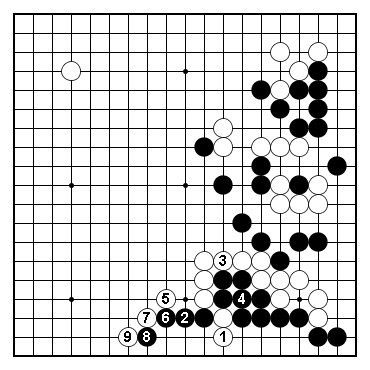 Dia. 4
Dia. 4Black created defects in White's formation with 10 and 12 in Dia. 5 before defending with 14. White captures in a ladder with 15 and the dust is settled here for now. White is left with a cut at A, true, but compared to Dia. 3, this one is much less of a problem for White, because the White group that Black would cut with A is "wider", has more breathing space in the center.
Also, White's wall is so close to the lower left corner and it has such a great influence in that area, that Black will have to be very cautious when playing in that corner.
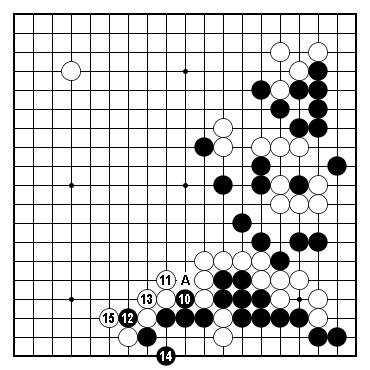 Dia. 5
Dia. 5Game 2
Game 2 was played on March 29th, 2007. Cho Chikun won by 2.5 points.
The second game was very spectacular as well: a fight started early on, when Cho didn't want to connect at A (and let Yamashita get the ideal extension at B), but decided to protect against the cut in sente, with the tsuke of Black 23 in Dia. 6, so he can play first on the lower side.
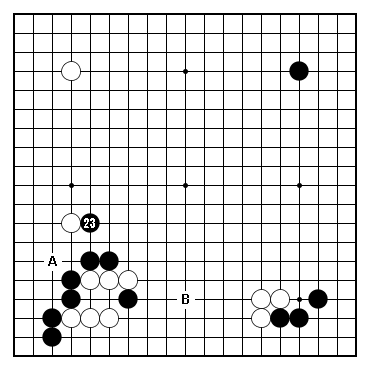 Dia. 6
Dia. 6The result was a fight between 4 groups without eye shape, on the lower side. Another very interesting situation occurred at move 43 in Dia. 7: Black obviously has to play around A, to defend his cutting point; if he does that directly, though, White could press with B and settle his 3 stones while taking advantage of Black's weakness in the corner. So Black decided to play 43, which (obviously) defends against White B, but also defends his cutting point on the left of A indirectly: if White cuts there, Black can just play atari from underneath and keep extending to the right until he cuts and captures the 3 White stones, thanks to the presence of his stone 43. Just like in the previous diagram, Black wants to be in the driver's seat in this game, he doesn't just want to follow the flow.
Note: according to Pieter Mioch's article, Cho regretted 43 a lot, and that should have been directly at A.
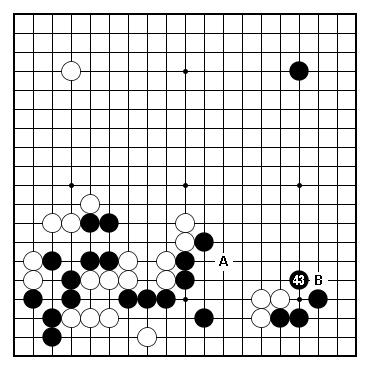 Dia. 7
Dia. 7After move 76, the situation is the one in Dia. 8. White sacrificed his stones in the lower right corner in exchange for a ponnuki and a lot of influence on the right side. He even extended from that influence as much as possible. It's Black's turn to play and do something about White's right side, before that turns into solid territory. I was very surprised by Black's approach as I was following this game live on IGS.
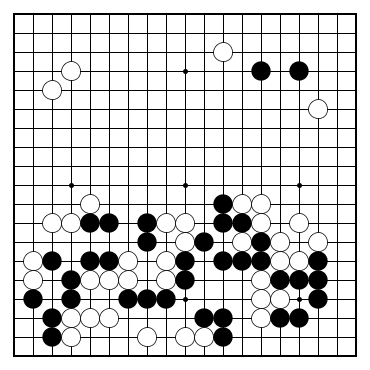 Dia. 8
Dia. 8First move I was surprised of was Black 77; I admit I shouldn't have been surprised by it, since it is a common tesuji after all (it threatens to connect on the second line, with a ko) - but after White's ponnuki and extra moves, White's wall looks so big and scary, that I was somehow treating White's wall with too much respect (or fear?). The second move that surprised me was Black 79: I expected something like Black A, a more shallow reduction. But here is Black 79, much more severe that A, and threatening to make a living group inside White's moyo, and turn White's wall below into just a simple group that has to care for its own eyes. Which White does with 82 and 84 - White is moving his group out, so he doesn't have to suffer the indignity of having to make eyes for it locally. Next, with move 86 White has to take care of the other half of what was originally his moyo - and that started yet another fight.
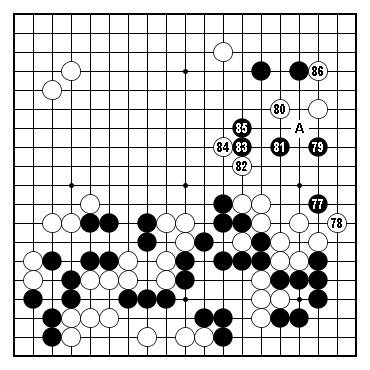 Dia. 9
Dia. 9Game 3
Game 3 was played on April 5th, 2007. Yamashita won by resignation.
This looked like a good solid game from Yamashita, who built a very large moyo around san-ren-sei, forced Cho to invade, then went to take profit outside.
Game 4
Game 4 was played on April 19th, 2007. Yamashita won by resignation.
An unusually short game: Yamashita forced a resignation from Cho in just 106 moves.
Game 5
Game 5 was played on April 25th, 2007. Cho Chikun won by 3.5 points
